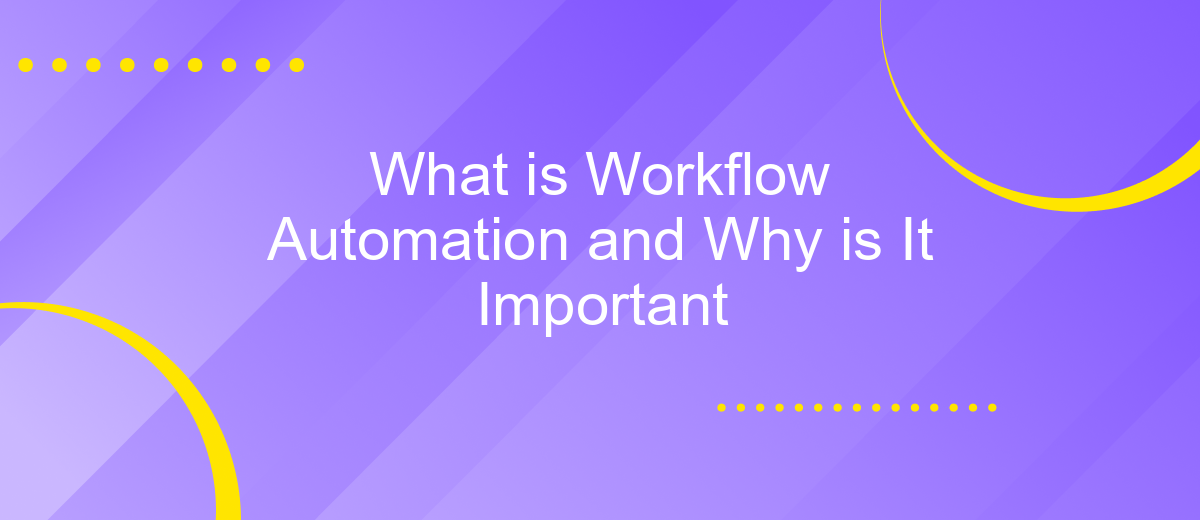What is Workflow Automation and Why is It Important
Workflow automation refers to the use of technology to streamline and automate repetitive tasks and processes within an organization. By minimizing manual intervention, it enhances efficiency, reduces errors, and frees up employees to focus on more strategic activities. Understanding workflow automation and its importance can significantly impact productivity and drive business growth in today's fast-paced digital world.
Introduction: Understanding Workflow Automation
Workflow automation is a powerful tool that enables businesses to streamline their processes and improve efficiency. By automating repetitive tasks, companies can save time, reduce errors, and focus on more strategic activities. This not only enhances productivity but also leads to better resource management and cost savings.
- Reduces manual errors
- Increases efficiency and productivity
- Frees up time for strategic tasks
- Improves resource management
- Facilitates better decision-making
One of the key aspects of workflow automation is the integration of various tools and systems. Services like ApiX-Drive make it easy to connect different applications, ensuring seamless data flow and communication. By leveraging such integrations, businesses can create a cohesive and efficient operational environment, ultimately driving growth and success.
Benefits and Advantages of Workflow Automation

Workflow automation streamlines repetitive tasks, reducing the time and effort required to complete them. By automating processes, businesses can minimize human error, enhance productivity, and ensure consistency in operations. This leads to significant cost savings and allows employees to focus on more strategic and creative tasks that add greater value to the organization. Moreover, automation provides real-time tracking and monitoring, enabling better decision-making and more efficient resource allocation.
Another key advantage of workflow automation is its ability to integrate various systems and applications seamlessly. Services like ApiX-Drive facilitate these integrations, allowing for smooth data transfer and synchronization between different platforms. This not only improves data accuracy and accessibility but also enhances collaboration across departments. By leveraging workflow automation, businesses can achieve greater operational efficiency, improved customer satisfaction, and a competitive edge in the market.
Types and Examples of Workflow Automation

Workflow automation can streamline various business processes, saving time and reducing errors. Different types of workflow automation cater to specific needs, making it essential to understand their functionalities and applications.
- Task Automation: This involves automating repetitive tasks such as data entry, email responses, and scheduling. Tools like Zapier and ApiX-Drive can connect various apps to automate workflows seamlessly.
- Process Automation: This type focuses on automating entire business processes, such as order processing or employee onboarding. Solutions like UiPath and Blue Prism are commonly used for this purpose.
- Document Automation: Automating the creation, approval, and storage of documents helps in maintaining consistency and compliance. Services like DocuSign and PandaDoc are popular choices.
- Integration Automation: This involves integrating different systems and applications to work together without manual intervention. ApiX-Drive is an excellent tool for setting up these integrations efficiently.
Implementing workflow automation enhances productivity, reduces operational costs, and improves accuracy. By selecting the right type of automation for your needs, you can significantly optimize your business processes.
Implementation and Challenges of Workflow Automation

Implementing workflow automation involves several key steps, starting with identifying repetitive tasks that can be automated. This requires a thorough analysis of current workflows to pinpoint inefficiencies and potential areas for automation. Once identified, the next step is selecting the right automation tools and software that align with the organization's needs.
One of the primary challenges in implementing workflow automation is the integration of various systems and applications. Ensuring seamless communication between different platforms can be complex. Tools like ApiX-Drive can simplify this process by providing a user-friendly interface for setting up and managing integrations between diverse applications.
- Identifying repetitive tasks
- Selecting appropriate automation tools
- Ensuring seamless integration
- Training staff on new systems
- Monitoring and optimizing automated workflows
Another significant challenge is the initial resistance from employees who may be wary of changes to their routine. Providing adequate training and demonstrating the benefits of automation can help in gaining their support. Continuous monitoring and optimization are essential to ensure the automated workflows remain efficient and effective over time.
Conclusion: Transforming Business with Workflow Automation
Workflow automation is revolutionizing the way businesses operate by streamlining processes, reducing manual tasks, and enhancing overall productivity. By automating repetitive tasks, companies can allocate resources more efficiently, allowing employees to focus on higher-value activities that drive innovation and growth. This transformation not only improves operational efficiency but also leads to significant cost savings and faster turnaround times.
Integrating workflow automation tools, such as ApiX-Drive, further enhances this transformation by seamlessly connecting various applications and services. ApiX-Drive enables businesses to automate data transfer between platforms, ensuring that information flows smoothly without human intervention. This level of integration is crucial for maintaining data accuracy and consistency across different systems, ultimately leading to better decision-making and improved business outcomes. Embracing workflow automation is no longer a luxury but a necessity for businesses aiming to stay competitive in today's fast-paced environment.
FAQ
What is workflow automation?
Why is workflow automation important?
How can workflow automation benefit my business?
What types of tasks can be automated?
How do I get started with workflow automation?
Apix-Drive will help optimize business processes, save you from a lot of routine tasks and unnecessary costs for automation, attracting additional specialists. Try setting up a free test connection with ApiX-Drive and see for yourself. Now you have to think about where to invest the freed time and money!

